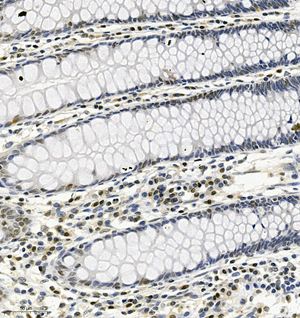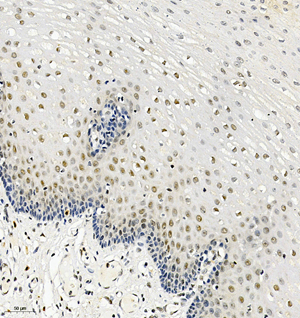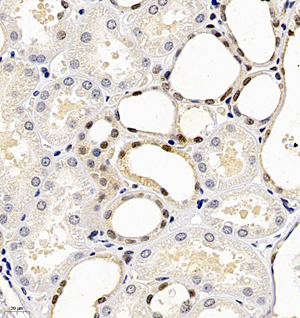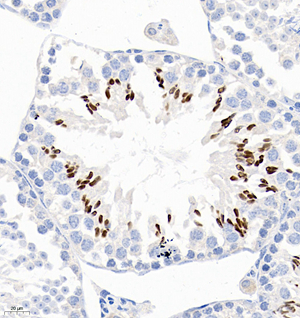Anti-HDAC3 Rabbit pAb (100 μl)
| Reactivity: | H,M |
| Applications: | IHC/IF |
| Host Species: | Rabbit |
| Clonality: | Polyclonal |
| Gene Name: | Histone deacetylase 3 |
Synonyms: | HD3, HDAC3, histone deacetylase 3, RPD3, RPD3 2, SMAP45 |
Immunogen: | KLH conjugated Synthetic peptide corresponding to Mouse HDAC3 |
Uniprot ID: | O88895 |
Isotype: | lgG |
Purity: | Affinity purification |
Subcellular location: | Nucleus, Cytoplasm |
Product Usage Information
IHC/IF | Human, Mouse | 1: 50-1: 150 | kidney, testis, colon |
Background
Responsible for the deacetylation of lysine residues on the N-terminal part of the core histones , and some other non-histone substrates. Histone deacetylation gives a tag for epigenetic repression and plays an important role in transcriptional regulation, cell cycle progression and developmental events. Histone deacetylases act via the formation of large multiprotein complexes. Participates in the BCL6 transcriptional repressor activity by deacetylating the H3 'Lys-27' on enhancer elements, antagonizing EP300 acetyltransferase activity and repressing proximal gene expression. Probably participates in the regulation of transcription through its binding to the zinc-finger transcription factor YY1; increases YY1 repression activity. Required to repress transcription of the POU1F1 transcription factor. Acts as a molecular chaperone for shuttling phosphorylated NR2C1 to PML bodies for sumoylation. Contributes, together with XBP1 isoform 1, to the activation of NFE2L2-mediated HMOX1 transcription factor gene expression in a PIK/mTORC2/Akt-dependent signaling pathway leading to endothelial cell survival under disturbed flow/oxidative stress. Regulates both the transcriptional activation and repression phases of the circadian clock in a deacetylase activity-independent manner. During the activation phase, promotes the accumulation of ubiquitinated ARNTL/BMAL1 at the E-boxes and during the repression phase, blocks FBXL3-mediated CRY1/2 ubiquitination and promotes the interaction of CRY1 and ARNTL/BMAL1. The NCOR1-HDAC3 complex regulates the circadian expression of the core clock gene ARTNL/BMAL1 and the genes involved in lipid metabolism in the liver. Serves as a corepressor of RARA, causing its deacetylation and inhibition of RARE DNA element binding. In association with RARA, plays a role in the repression of microRNA-10a and thereby in the inflammatory response.
Images
| Immunohistochemistry analysis of paraffin embedded human colon using HDAC3 (GB115591) at dilution of 1:150 |
| Immunohistochemistry analysis of paraffin embedded human esophagus using HDAC3 (GB115591) at dilution of 1:150 |
| Immunohistochemistry analysis of paraffin embedded human kidney using HDAC3 (GB115591) at dilution of 1:150 |
| Immunohistochemistry analysis of paraffin embedded mouse testis using HDAC3 (GB115591) at dilution of 1:150 |
Storage
| Storage | Store at -20°C for one year. Avoid repeated freeze/thaw cycles. |
| Storage Buffer | PBS with 0.02%sodium azide,100 μg/ml BSA and 50% glycerol. |




